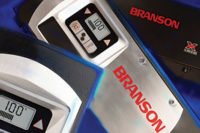It's hard not to think of a robot as a person-a fast, accurate, tireless person. Nonetheless, equating the abilities of robots and human beings is risky. What's easy for a human assembler can be difficult or impossible for a robot. To ensure success with robotic assembly, engineers must adapt their parts, products and processes to the unique requirements of the robot.
For example, unlike human assemblers, robots cannot hold a part in one hand and a tool in the other. Rather, SCARA and Cartesian robots are "one-handed" and can only move along three or four axes. As a result, products should be designed so they can be assembled in layers from the bottom up.
Along these same lines, parts should be designed to stay in place after they are installed by the robot. Better still, parts can be designed with snap fits, eliminating the need for fastening, welding or bonding later. In addition, because robots cannot move with the same repeatability as dedicated, "hard" automation, parts should have self-aligning features, such as lips or chamfers, to help the robot insert them. If parts have to be forced together during assembly, as opposed to just falling into place, a robot is likely going to have problems.
Robotic grippers are not as nimble as human hands, and some parts are easier for robots to grip than others. A part with two parallel surfaces can be handled by a two-fingered gripper. A circular part can be handled by its outside edges or, if it has a hole in the middle, its inside edges. Adding a small lip to a part can help a gripper reliably manipulate the part and increase the efficiency of the system. If the robot will handle more than one type of part, the parts should be designed so they can all be manipulated with the same gripper.
How well the parts are made can also be an issue. Although robots are flexible in the sense that they can be programmed to assemble different products, they can have a hard time compensating for inconsistency. As a result, if you have one part that is manufactured to, say, a tolerance of 0.01 inch and another part that is made to a tolerance of 0.005 inch, you may have a hard time getting a robot to successfully put those parts together.
Beyond that, it's important to pay attention to the way parts are presented to the robot. As is the case with other automated assembly systems, parts that are going to be supplied by vibratory feeders should be designed so they won't tangle or overlap. Once the parts are in the output track, the robot should be able to pick up a part and insert it without any further manipulation.
If parts are going to be delivered in trays, the parts should rest in the pockets in a consistent, stable position. The pockets should provide clearance for the gripper's fingers, and, as with bowl feeders, the robot should be able to pick up a part and insert it without any further manipulation. Equipping the robot with a self-centering gripper will allow engineers to use less precise trays or fixtures.
One advantage of vision-guided robotic assembly is that these kinds of hard-tooled feeders may not be necessary. Instead, parts can be delivered to the robot riding loosely on a conveyor. A vision system, mounted above the conveyor or on the robot arm, tells the robot where to find the parts and which ones are in the correct orientation.
Bear in mind, though, that for machine vision to work effectively, engineers must make sure the parts have a consistent visual appearance. They can also include features that enable easy recognition. For example, engineers can add a boss or other feature to a double-sided part to help a vision system distinguish one side from another.




